Best Cloud Providers for Budget AI Deployments
Explore cost-effective cloud providers for AI deployments, comparing pricing, performance, and scalability to optimize your budget.

AI projects often come with high costs, but choosing the right cloud provider can help you save money without sacrificing performance. Here's what you need to know:
- AWS: Offers a wide range of AI tools and flexible pricing but watch for hidden costs like data transfers and idle resources.
- Google Cloud (GCP): Competitive GPU pricing and AI-specific tools like Vertex AI, but egress fees can add up.
- Microsoft Azure: Strong enterprise integration and hybrid options, though pricing can be complex and higher upfront.
- Oracle Cloud: Affordable compute options for AI, but fewer AI-focused tools compared to others.
- IBM Cloud: Watson AI tools and strong compliance features, but higher costs and slower development cycles.
- Lambda Labs: Transparent, low-cost GPU pricing ideal for researchers and small teams.
- Paperspace (DigitalOcean): Affordable and user-friendly for smaller teams, but may lack scalability for larger projects.
- Nebius: EU-focused, cost-friendly, but limited outside Europe.
- Hyperstack: Low GPU pricing with free data transfer, but fewer general-purpose compute options.
Quick Comparison
| Provider | Strengths | Weaknesses | Best For |
|---|---|---|---|
| AWS | Broad ecosystem, scalable | Hidden costs, complex pricing | Large enterprises |
| Google Cloud | AI tools, GPU pricing | Egress fees, smaller footprint | AI-centric projects |
| Azure | Enterprise-ready, hybrid cloud | High costs, complex pricing | Microsoft ecosystem users |
| Oracle Cloud | Affordable compute options | Limited AI tools | Compute-heavy tasks |
| IBM Cloud | Watson AI, compliance | High costs, slower pace | Regulated industries |
| Lambda Labs | Transparent GPU pricing | Limited infrastructure | Researchers, small teams |
| Paperspace | Affordable, user-friendly | Scalability issues | Small projects |
| Nebius | EU compliance, cost-friendly | Limited global reach | EU-based users |
| Hyperstack | Low GPU costs, free transfers | Fewer general-purpose options | GPU-heavy workloads |
Each provider has its pros and cons. Start with free trials or credits to test which one meets your budget and performance needs.
1. AWS (Amazon Web Services)
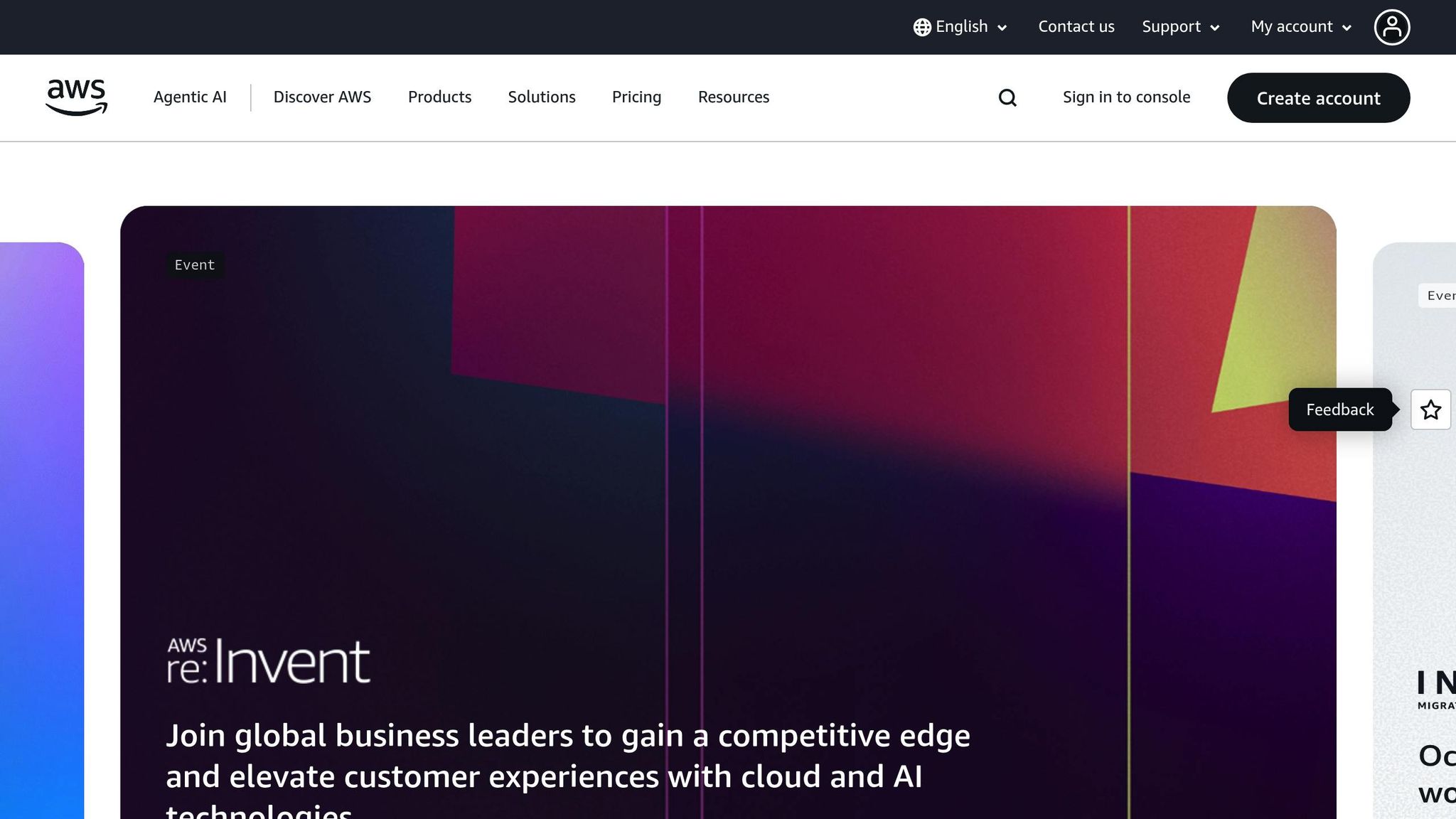
Amazon Web Services (AWS) continues to hold a leading position in the cloud computing space, offering a wide range of options for deploying AI solutions. Whether you're looking for pre-built tools like Amazon SageMaker or raw compute power with GPU-enabled instances, AWS has something for almost every need.
Pricing
AWS offers flexible pricing models to suit different workloads. For example:
- GPU-enabled EC2 instances: Ideal for those requiring raw computational power.
- Amazon SageMaker: Separates costs for training and inference, with a serverless inference option that’s a great fit for workloads that aren’t constant.
- Spot Instances: These can significantly reduce costs compared to On-Demand pricing, making them attractive for non-critical tasks.
This variety allows users to optimize costs while accessing high-performance resources.
Performance
AWS supports a range of GPUs, including NVIDIA T4, V100, and A100, which deliver strong performance for tasks like distributed training and high-speed data transfers. With Amazon SageMaker, users benefit from features like automated model loading and scaling, ensuring consistent performance even as traffic fluctuates. For those with particularly demanding workloads, AWS also offers specialized high-performance computing instances to meet their needs.
Scalability
AWS is built to scale effortlessly, whether you're running a single instance or a large distributed cluster. Key features like Auto Scaling Groups, Elastic Load Balancing, and SageMaker tools (e.g., Multi-Model Endpoints and Training Jobs) dynamically adjust resources to handle varying workloads, helping businesses stay efficient as their needs grow.
Hidden Costs
While AWS provides many cost-efficient tools, it’s important to keep an eye on potential hidden expenses. These can include:
- Cross-region data transfers
- Model artifact storage
- Logging and monitoring fees
- NAT Gateway charges
- Idle resources like unused SageMaker Studio notebooks
Understanding these additional costs is crucial for managing your budget effectively. While AWS delivers strong performance and scalability, these extra charges can add up if not carefully monitored.
2. Google Cloud Platform (GCP)
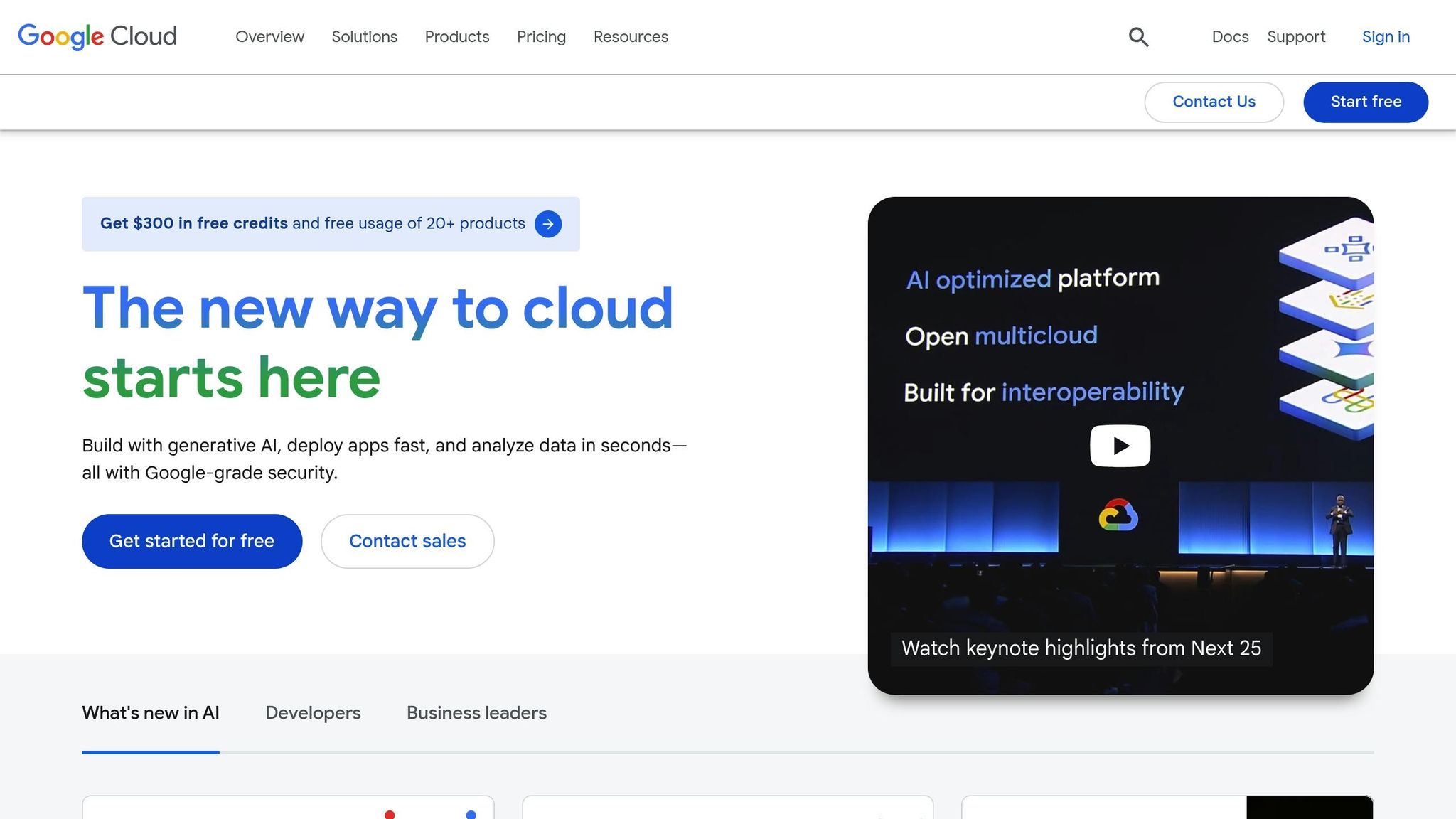
Google Cloud Platform (GCP) is an appealing choice for those aiming to manage AI deployments on a budget. With Google's extensive experience in machine learning and artificial intelligence, GCP combines competitive pricing, advanced AI tools, and a dependable infrastructure to create an affordable yet powerful environment for AI projects.
Pricing
GCP's pricing structure is designed with cost-conscious users in mind, offering several automated ways to save. For example, sustained use discounts automatically lower costs when compute resources are used consistently over a billing cycle - no upfront commitments needed.
Another cost-saving feature is preemptible instances, which are significantly cheaper than regular ones. These are particularly useful for batch processing, machine learning training, and other workloads that can handle interruptions, making them a smart option for AI tasks. For AI-specific needs, Vertex AI offers a pay-per-use pricing model for both training and predictions.
Customers committing to long-term resource use can benefit from committed use discounts, and with GCP's per-second billing, you only pay for the exact compute time used. These flexible pricing options make GCP an economical choice without compromising on performance.
Performance
GCP is equipped to handle demanding AI workloads with speed and efficiency. It offers custom Tensor Processing Units (TPUs) and supports NVIDIA GPUs (A100, V100, T4) for high-performance computing and fast data processing.
Key services like Google Kubernetes Engine (GKE) enable streamlined container orchestration, while Vertex AI simplifies the management of machine learning workflows. GCP's global network infrastructure, paired with premium-tier networking, ensures low-latency access to services by routing traffic through Google's private network.
Scalability
GCP excels at scaling to meet the needs of AI projects. Many of its services, such as Vertex AI, feature automatic scaling to adjust training jobs and prediction endpoints based on demand. Cloud Run offers serverless scaling for containerized applications, adapting to workload requirements without manual intervention.
For storage, GCP provides solutions tailored to intensive AI demands. Persistent disks and Filestore handle high data throughput, while BigQuery enables large-scale analytics and machine learning on massive datasets. Additionally, GKE Autopilot mode simplifies Kubernetes cluster management by automatically adjusting node capacity to meet workload requirements, keeping operations efficient and costs under control.
Hidden Costs
While GCP offers many ways to save, some hidden costs can arise. For example, network egress charges may add up when transferring large datasets or model outputs between regions or to external systems. Similarly, storage costs can grow if large volumes of training data, model checkpoints, or logs are retained without proper lifecycle management.
Other potential expenses include charges for services like logging and monitoring, load balancing, or NAT gateways for private clusters. To avoid surprises, it's crucial to use GCP's cost management tools, set budget alerts, and regularly review spending to identify areas where costs can be optimized.
3. Microsoft Azure

Microsoft Azure has positioned itself as a solid choice for businesses looking to deploy AI solutions on a budget. Recent surveys show that Azure's adoption rates have slightly surpassed AWS, thanks to its mix of competitive pricing and strong performance capabilities. This combination makes Azure appealing for organizations aiming to implement AI without overspending.
Pricing
Azure provides a variety of pricing models tailored to different budgets and usage needs. These include Standard (Pay-As-You-Go), Provisioned Throughput Units (PTUs), and Batch API options for its AI services. A standout feature is its Azure Spot Virtual Machines, which offer predictable and consistent discounts. These Spot Instances can reduce costs by as much as 65–69% compared to standard rates. Additionally, Azure offers savings plans like Azure reservations and the Azure Hybrid Benefit, which allows businesses to leverage existing Windows Server and SQL Server licenses to cut expenses further. These pricing options make Azure an attractive choice for cost-conscious AI deployments.
Performance
Azure's infrastructure is designed to handle demanding AI workloads with efficiency. It provides access to Azure AI Foundry, a unified environment featuring over 11,000 models from providers like OpenAI, Meta's Llama, Mistral AI, xAI's Grok, DeepSeek, and FLUX. Users can tap into a wide range of pre-trained and customizable AI models through services such as Azure OpenAI Service, Azure AI Search, and Azure AI Content Safety. Specialized tools for tasks like document processing, speech recognition, language translation, and vision analysis are also available. Azure's flexible deployment options - Global, Data Zone (geographic-specific like EU or US), and Regional - help organizations optimize both performance and compliance.
Scalability
Azure's infrastructure is built to grow alongside your AI needs. Its scalable design supports both pay-as-you-go and provisioned throughput models, allowing businesses to adjust resources based on demand. The platform’s cloud-based tools streamline development and deployment, keeping costs manageable while leaving room for future growth. For enterprise-level deployments, organizations should expect a timeline of 6–12 months for full implementation.
Hidden Costs
While Azure offers many ways to save, there are potential hidden costs to consider. Maintenance, compliance requirements, and the need for specialized talent can significantly impact your budget. In fact, talent-related expenses - covering AI engineers, data scientists, architects, and project managers - can account for 40–60% of total project costs. To avoid unexpected expenses, take advantage of Azure's cost management tools, such as Copilot in Microsoft Cost Management, FinOps best practices, and Azure Advisor recommendations. Using the Azure pricing calculator can also help you estimate costs upfront. For businesses aiming to scale AI operations without overspending, understanding and planning for these hidden costs is essential.
4. Oracle Cloud
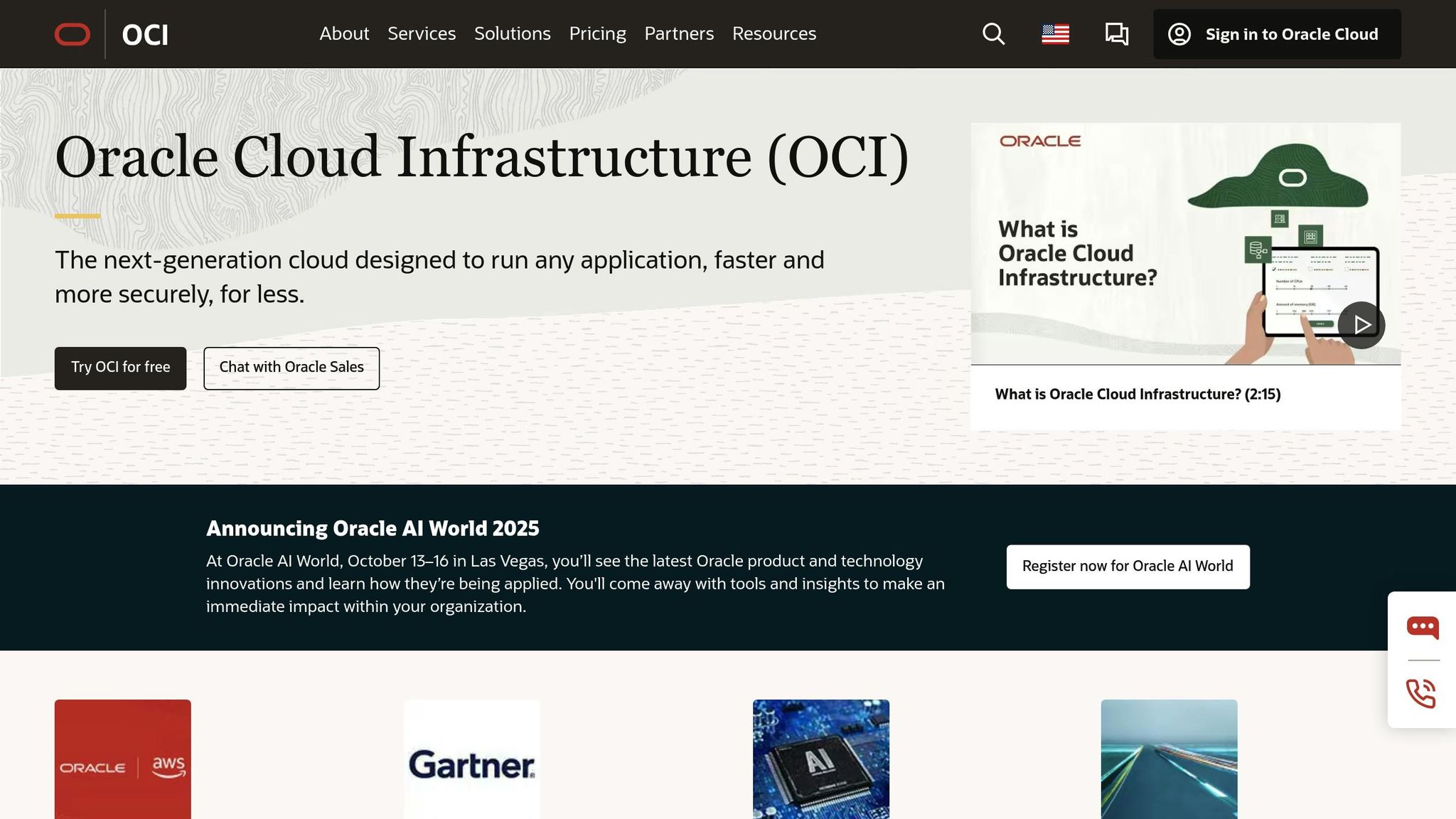
Oracle Cloud Infrastructure (OCI) has become an attractive choice for businesses seeking cost-effective, high-performance AI solutions. While it may not have the same level of recognition as AWS or Azure, OCI's specialized AI clusters and transparent pricing make it a strong contender for large language model (LLM) workloads. This setup allows organizations to achieve impressive efficiency without breaking the bank.
Pricing
Oracle Cloud's dedicated AI clusters are designed to cut costs for LLM inference while adapting dynamically to changing demand. This approach can lead to notable savings compared to using general-purpose compute instances. It’s particularly well-suited for offline batch processing, where immediate response times aren’t critical. This makes it an excellent option for processing large token volumes efficiently and economically.
Performance
OCI offers reliable performance through its Generative AI service, tailored to handle varying workloads. Its infrastructure supports token-level throughput, accommodating workloads at about 5 tokens per second - roughly matching the speed of human reading - and scaling up to 15 tokens per second for near real-time interactions. This flexibility ensures that it can meet the needs of both steady and high-demand scenarios.
Scalability
Oracle Cloud's AI cluster architecture is built with scalability in mind. It allows businesses to expand their LLM inference capabilities based on actual usage, eliminating the need to maintain constant peak capacity. This adaptability is especially beneficial for organizations with fluctuating AI workloads, helping them manage resources efficiently during busy periods while trimming costs during slower times.
5. IBM Cloud
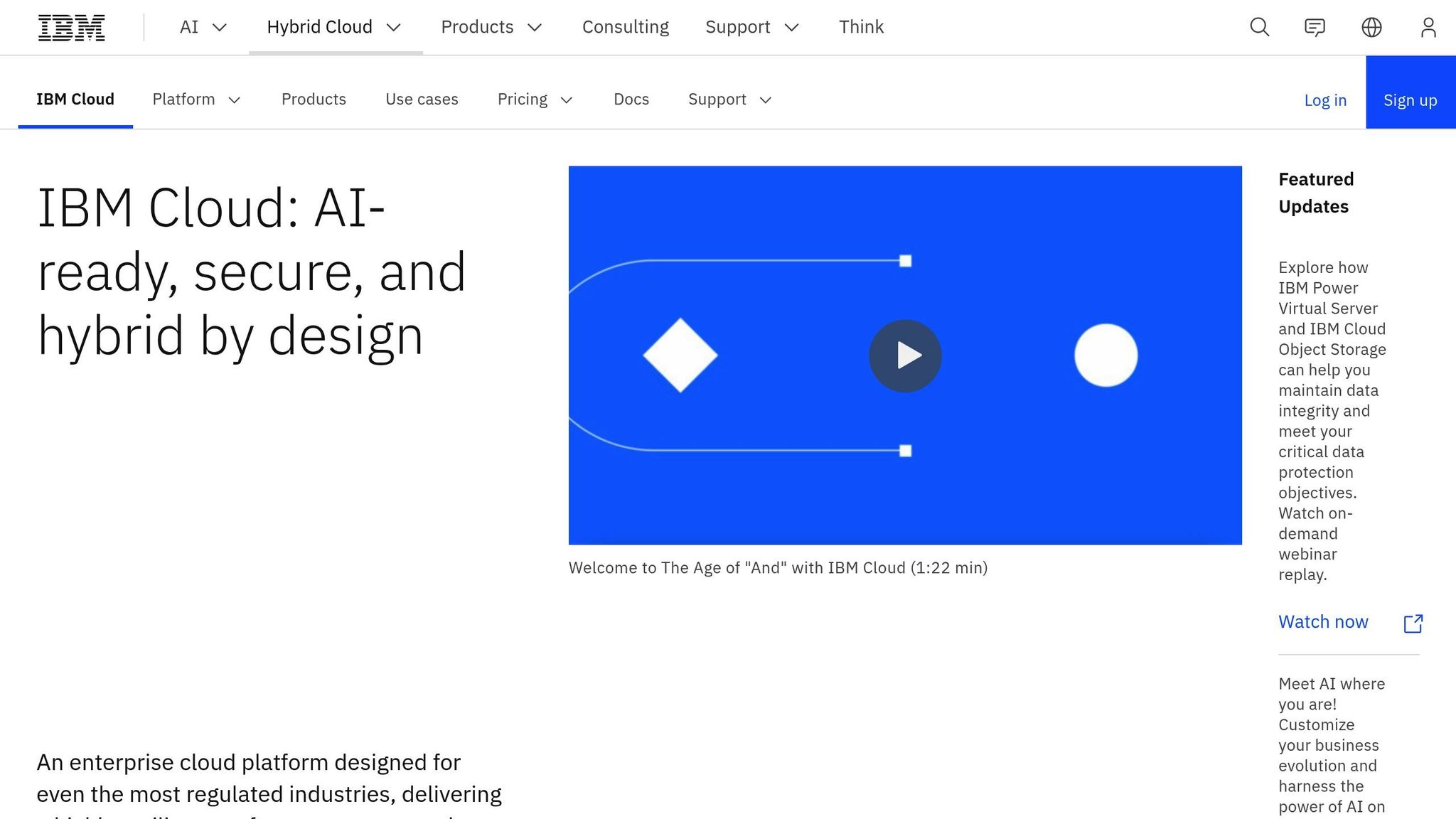
IBM Cloud combines its powerful Watson Machine Learning capabilities with a cost-conscious approach, offering a reliable solution for organizations in need of dependable AI tools without breaking the bank. Its infrastructure is designed to merge specialized AI features with affordability, making it a strong contender in the cloud services market.
Pricing
IBM Cloud operates on a pay-as-you-go model, ensuring you only pay for the compute time you actually use. With Watson Machine Learning, this means charges are based solely on the time spent training or running inference models. For those just starting out, there's a free Watson tier that allows for experimentation before committing to larger-scale projects. Additionally, long-term users benefit from automatic discounts, which help keep costs manageable for sustained usage.
Performance
When it comes to performance, IBM Cloud doesn't cut corners. The platform is backed by cutting-edge hardware and Watson Studio, a tool designed to simplify AI development. Its global network of data centers supports multi-zone deployments, ensuring low latency and consistent reliability for AI applications. Plus, with integrated cloud object storage, data retrieval for training and inference is quick, keeping operations running smoothly.
Scalability
Scalability is where IBM Cloud truly shines. Its integration with Kubernetes allows for dynamic resource allocation through auto-scaling, making it easy to adapt to changing needs. For large-scale inference tasks, the Watson Machine Learning service supports batch processing, handling high volumes of predictions efficiently. Moreover, the platform's compatibility with container orchestration tools lets businesses deploy and scale AI applications seamlessly across hybrid environments, whether on-premises, in the cloud, or a mix of both.
Hidden Costs
While IBM Cloud offers competitive base pricing, it's important to keep an eye on potential extra charges. These may include fees for data transfers, additional storage costs, and premium support services, which can add up over time. Always review these details to avoid surprises.
6. Lambda Labs
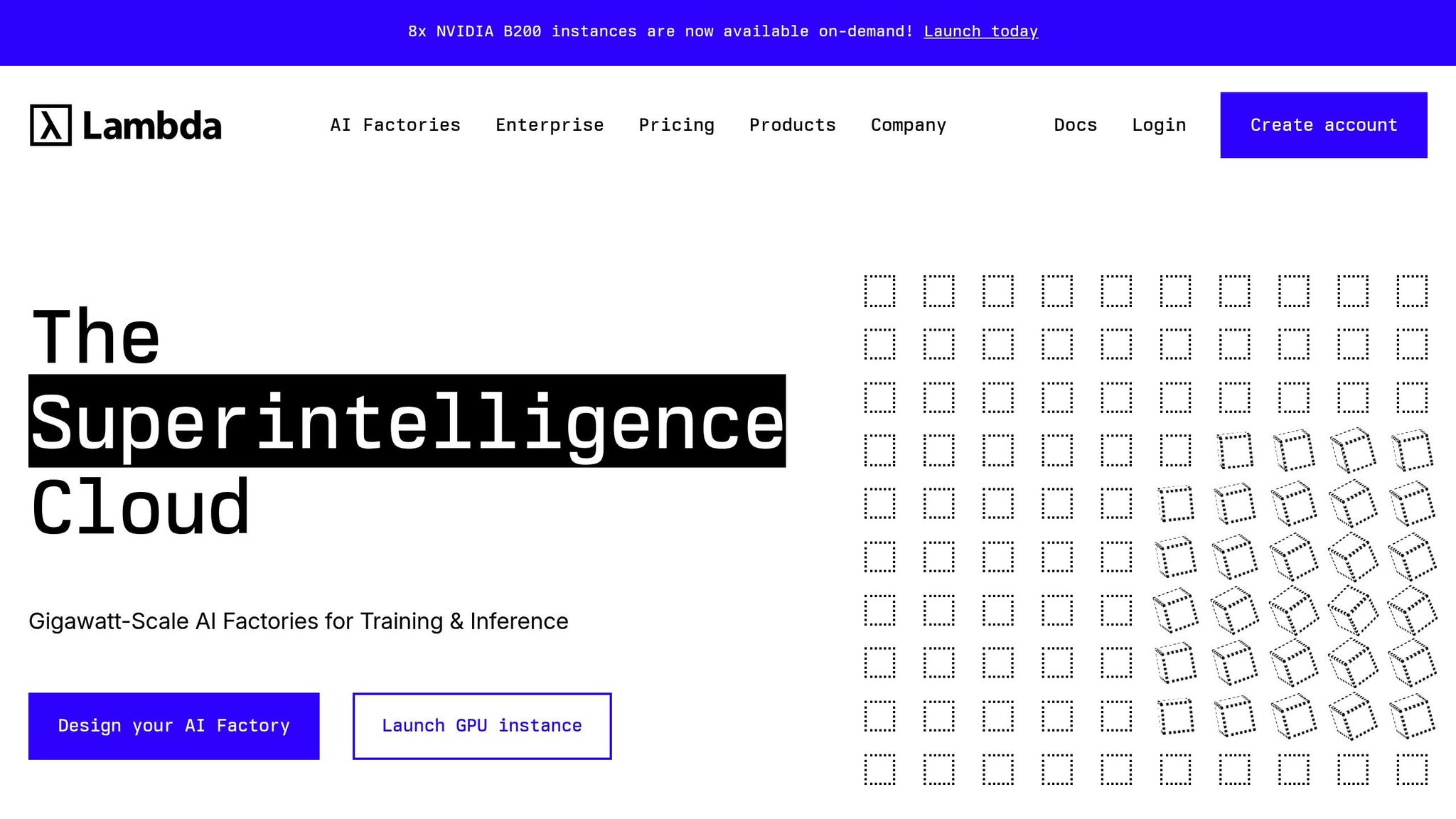
Lambda Labs is a cloud provider focused on GPUs, designed to make AI deployments more affordable. Established in 2012 as a response to high AWS costs, the company has carved out a niche by offering AI-specific infrastructure at a lower price point. This makes it an appealing option for teams looking to manage expenses without sacrificing performance.
Pricing
Lambda Labs is known for its straightforward and budget-friendly pricing. For example, their on-demand 8x NVIDIA H100 SXM configurations cost $2.99 per hour, which is a fraction of AWS's rate of over $12.00 per hour. The pay-by-the-minute model ensures you only pay for the time you actually use, making it ideal for short tasks like quick inference or brief training runs. For projects with predictable workloads, reserved instances can cut costs by 30–40% compared to always-on setups.
They also offer one-click clusters for easy multi-node setups and reserved capacity for teams with consistent compute demands. Additionally, their AI inference API uses a simple per-token pricing structure, making it a practical choice for production environments. This pricing model balances affordability with high performance.
Performance
Lambda Labs provides access to top-tier NVIDIA GPUs, including B200, H100, and A100 configurations. For instance, their 8x NVIDIA B200 SXM6 instances come with 180 GB of VRAM per GPU, while the H100 setups offer 80 GB of VRAM per GPU. The platform is fine-tuned for AI tasks, delivering excellent performance relative to cost, especially when compared to general-purpose cloud instances.
Scalability
The platform is built for scaling GPU resources efficiently. Unlike traditional hyperscalers, Lambda Labs focuses on vertical scaling with multi-GPU setups rather than widespread horizontal scaling. Their one-click clusters make it easy to set up multi-node environments for distributed training, while reserved instances guarantee access to high-end GPUs for ongoing projects. This approach ensures flexibility without compromising on cost-effectiveness.
Hidden Costs
One of the standout features of Lambda Labs is its transparent pricing. There are no hidden fees or surprise charges, such as egress fees. All costs are clearly stated upfront, making it easier to plan and stick to your budget.
7. Paperspace (DigitalOcean)
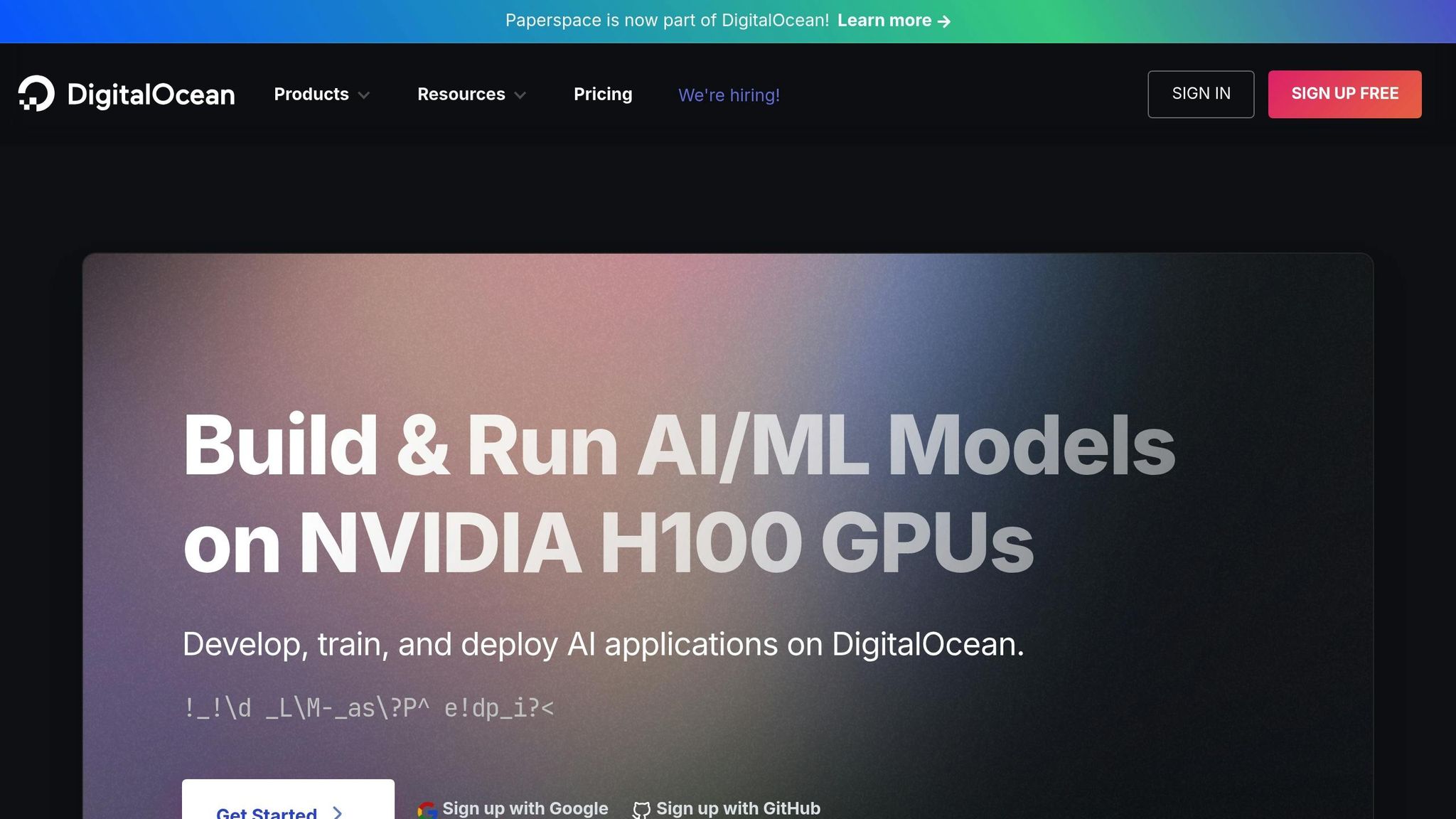
Paperspace, now part of DigitalOcean, offers an affordable solution for AI deployments. It combines cost savings with the high-performance capabilities needed for demanding AI workloads. By simplifying GPU computing and infrastructure management, it provides an accessible option for teams working on AI model deployment.
Pricing
Paperspace uses a tiered pricing system that combines Gradient Subscription Plans with hourly charges for compute, storage, and networking. To secure lower GPU rates, long-term commitments - such as 3-year reservations - are required. This setup works well for teams with steady and predictable workloads, as it can lead to noticeable cost reductions. However, teams with fluctuating compute needs should evaluate their usage patterns carefully before committing to extended plans.
Performance
The platform offers access to powerful NVIDIA GPUs like the H100 and L40S, along with AMD Instinct™ MI300X, making it suitable for both training and inference tasks. It also supports instant scaling for training sessions, with no runtime limits, ensuring teams can tap into a wide variety of GPU options whenever needed.
Scalability
Paperspace is designed to handle scaling efficiently. Its Deployments feature simplifies the process of serving models and managing scalable inference. Autoscaling capabilities allow resources to expand during traffic surges and contract during quieter periods. With user-friendly job scheduling and resource provisioning, teams can create scalable API endpoints and adjust resources on demand as workloads evolve.
Additional Considerations
While Paperspace offers straightforward pricing, it’s important to account for potential extra costs related to storage and networking, especially for data-heavy projects. Teams should also carefully weigh the benefits of long-term commitments against their projected workload needs when planning budgets.
8. Nebius
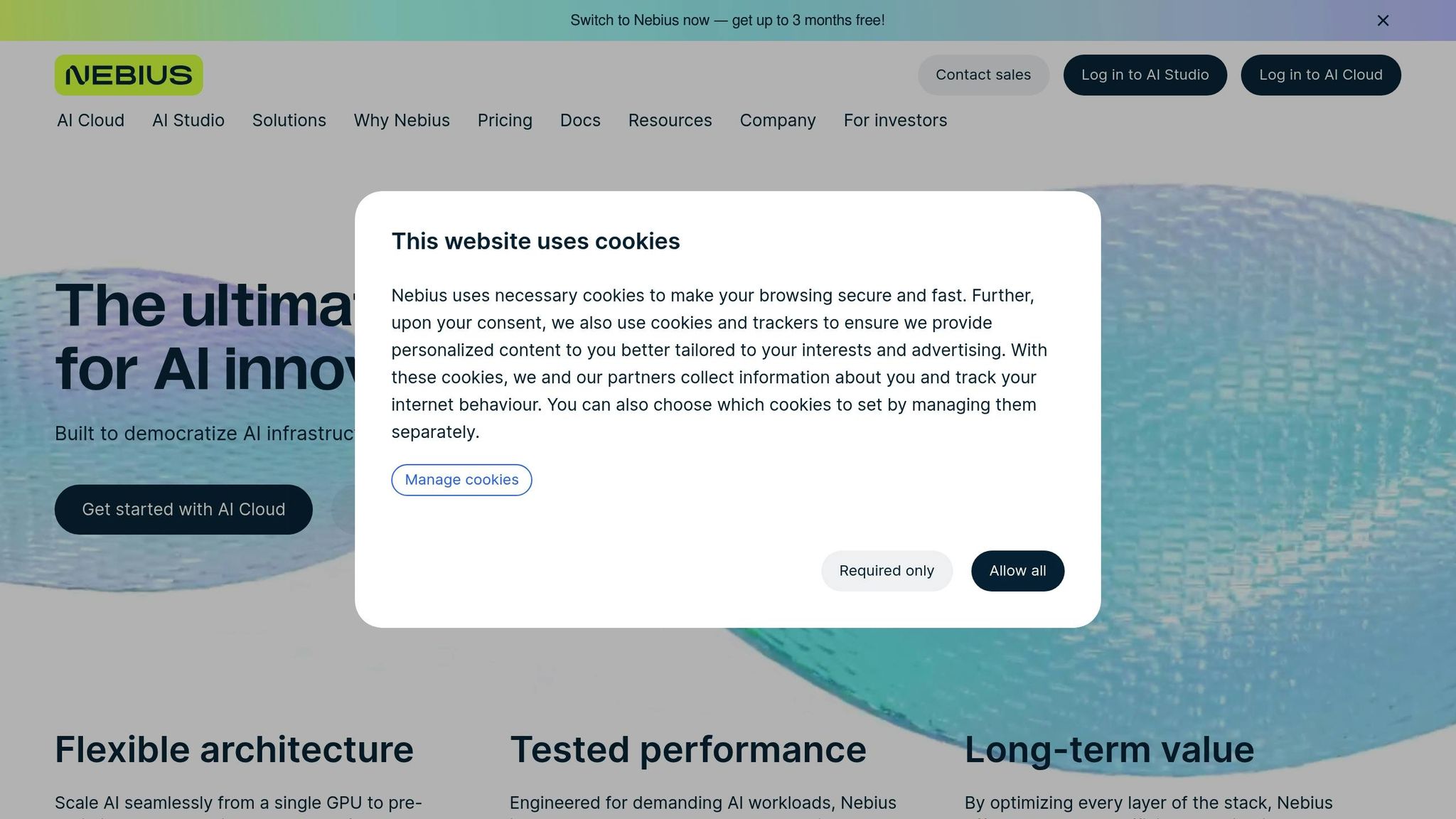
Nebius stands out as a less-documented option compared to providers with transparent public metrics. It focuses on offering budget-friendly AI deployment solutions but lacks comprehensive, verified information about its pricing, performance, and scalability. Make sure to carefully assess Nebius to ensure it aligns with your specific requirements.
9. Hyperstack
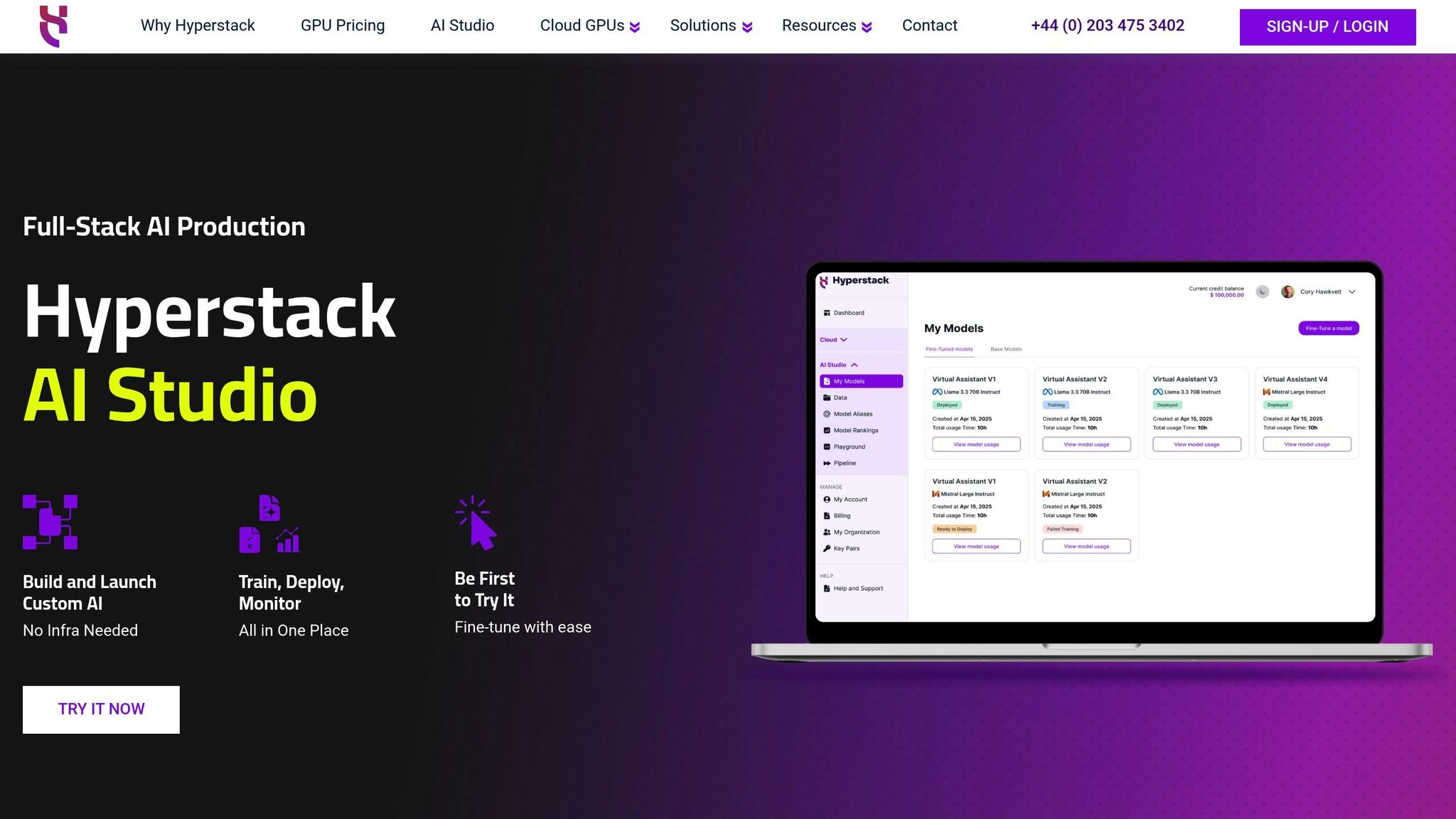
Hyperstack is a GPU-focused cloud platform that promises up to 75% savings compared to major cloud providers. It offers transparent, per-minute billing and a wide selection of NVIDIA GPUs to accommodate different AI deployment budgets.
Pricing
Hyperstack’s pricing structure is straightforward and flexible, with three main options: on-demand, reserved instances, and spot pricing. This variety allows users to pick what best suits their workload and budget.
For high-performance AI tasks, the NVIDIA H200 SXM costs $3.50 per hour on-demand, while the H100 options range from $1.90 per hour (PCIe) to $2.40 per hour (SXM). Reserved pricing offers noticeable savings, with H100 PCIe dropping to $1.33 per hour and H200 SXM at $2.45 per hour.
For those working with smaller budgets, Hyperstack’s lower-tier GPUs are a great starting point. The NVIDIA A4000 is available for just $0.15 per hour on-demand or $0.11 with reserved pricing. The A6000, another solid option for mid-level workloads, costs $0.50 per hour.
Spot pricing allows users to save even more, making it ideal for flexible workloads. For example, H100 PCIe is available at $1.52 per hour, and A100 instances cost $1.08 per hour. Additional costs include storage at ~$0.10 per TB per hour and public IPs at ~$0.00672 per hour. Data ingress and egress are completely free, adding to the platform’s affordability.
Performance
Hyperstack provides access to cutting-edge NVIDIA GPUs like the H200, H100, and A100, available in both SXM and PCIe configurations. These GPUs support NVLink connectivity, enabling high-bandwidth communication between GPUs, which is crucial for large-scale AI training.
The platform’s GPU-first design ensures it’s optimized for AI and machine learning workloads rather than general-purpose computing. This focus allows Hyperstack to deliver exceptional price-to-performance ratios for GPU-heavy tasks.
Beyond GPUs, Hyperstack also offers CPU instances ranging from 4-core ($0.35/hr) to 32-core ($3.74/hr) setups. Its AI Studio, priced by token usage, supports models like Llama 3.3 70B ($0.80 per million tokens) and Llama 3.1 8B ($0.20 per million tokens). These options make the platform versatile for both AI training and inference.
Scalability
Hyperstack is built to scale, offering on-demand scaling and reserved capacity options. Kubernetes services with free master nodes allow users to deploy containerized AI workloads that can scale horizontally across multiple GPU instances.
The VM hibernation feature is a standout tool for controlling costs. It lets users pause workloads without losing their progress, which is especially useful for development and testing environments where usage may be intermittent.
Reserved instances provide guaranteed capacity with savings of 20–30%, while spot pricing is perfect for cost-efficient batch processing.
Hidden Costs
Hyperstack prides itself on a transparent pricing model, but there are a few considerations to watch out for. Storage snapshots are priced based on VM size and attached volumes, so costs will vary depending on your configuration.
Per-minute billing helps reduce waste, but users should keep an eye on AI Studio token usage, as costs can add up quickly with high-throughput applications. Fine-tuning services, for instance, are priced at $0.063 per minute, which can become significant during lengthy training runs.
One big advantage is that Hyperstack includes free data transfer for both ingress and egress, removing a common source of unexpected fees. However, public IPs do come with a small cost (~$0.00672 per hour), so you’ll want to factor that in if your deployment requires external connectivity.
Advantages and Disadvantages
When it comes to budget AI deployments, every cloud provider has its own strengths and weaknesses. By weighing these trade-offs - like pricing, performance, scalability, and hidden costs - you can choose the provider that best fits your technical needs and budget.
Here’s a breakdown of the key advantages and challenges associated with each provider:
AWS stands out for its vast ecosystem and highly developed services. Its global infrastructure ensures reliability for large-scale operations. However, navigating its complex pricing structure and steep learning curve can be a hurdle, especially for newcomers.
Google Cloud Platform shines with its AI-focused services and competitive GPU pricing. It integrates seamlessly with TensorFlow and other Google AI tools, making it a favorite for AI development. That said, its smaller global footprint compared to AWS and fewer enterprise features might limit its appeal for certain large-scale deployments.
Microsoft Azure offers a strong mix of enterprise-ready features and AI capabilities. Its tight integration with Microsoft’s ecosystem and hybrid cloud options make it appealing for businesses already using Microsoft tools. However, higher baseline costs and a complicated pricing model can be a challenge for those on a tight budget.
Oracle Cloud is known for aggressive pricing and impressive performance for compute-heavy tasks. Its always-free tier is a great option for small projects. However, its limited AI-specific services and smaller partner network may pose challenges for advanced AI development.
IBM Cloud focuses on enterprise-level security and compliance, making it a strong choice for industries with strict regulations. Its Watson AI services offer pre-built solutions for common AI needs. On the downside, its higher costs and more traditional approach may not align with fast-paced, agile AI workflows.
Lambda Labs targets GPU workloads with clear, transparent pricing, making it accessible for researchers and smaller teams. However, its narrow focus means it’s not the best fit for those needing a full-fledged cloud infrastructure.
Paperspace is popular for its user-friendly interface and competitive GPU pricing, which are particularly appealing to individual developers and small teams. Its Gradient platform simplifies machine learning workflows, but limited enterprise features and scalability may become an issue as projects grow.
Nebius emphasizes European compliance and competitive pricing, making it a good option for organizations prioritizing data residency within the EU. However, its limited global reach restricts deployment options outside Europe.
Hyperstack is an excellent choice for those looking to save on GPU costs. With transparent per-minute billing and free data transfers, it eliminates many common cost surprises. However, its limited general-purpose computing options and relatively new presence in the market might give some enterprises pause.
To make this easier to digest, here’s a quick comparison table:
| Provider | Key Strengths | Main Weaknesses | Best For |
|---|---|---|---|
| AWS | Vast ecosystem, global infrastructure | Complex pricing, steep learning curve | Large enterprises, complex deployments |
| Google Cloud | AI-focused tools, competitive GPU pricing | Smaller global reach, fewer enterprise features | AI-centric projects, Google ecosystem users |
| Microsoft Azure | Enterprise integration, hybrid cloud options | Higher costs, complicated pricing | Microsoft-centric organizations |
| Oracle Cloud | Cost-effective, strong compute performance | Limited AI services, smaller ecosystem | Compute-heavy workloads, cost-conscious users |
| IBM Cloud | Strong security, compliance features | High costs, slower development pace | Regulated industries, enterprise clients |
| Lambda Labs | Transparent GPU pricing | Limited infrastructure scope | GPU-heavy research, small teams |
| Paperspace | Easy-to-use interface, affordable GPU pricing | Limited enterprise features | Individual developers, small projects |
| Nebius | EU compliance, competitive pricing | Limited global presence | EU-based organizations |
| Hyperstack | Low GPU costs, transparent billing | Limited general-purpose services | GPU-intensive AI workloads, cost optimization |
Startups and researchers often lean toward specialized providers like Lambda Labs or Hyperstack for their cost transparency and focus on GPU workloads. Mid-sized companies might prefer Google Cloud for its AI-native tools or Azure for its enterprise integration. Meanwhile, large enterprises are likely to stick with AWS, valuing its extensive global infrastructure and broad range of services despite its complexity.
Conclusion
Choosing the right cloud provider for budget AI projects comes down to matching your specific needs with the strengths of each platform. There's no universal solution, so it's essential to weigh the options carefully based on your goals and resources.
Startups and individual developers might find Lambda Labs and Hyperstack appealing due to their transparent, cost-effective GPU access and simple per-minute billing. If ease of use and a clean interface are top priorities, Paperspace is another strong contender.
Mid-sized companies looking to balance affordability with powerful AI tools could benefit from Google Cloud Platform's AI-focused features and competitive GPU pricing. Oracle Cloud also stands out as a solid option for compute-heavy tasks.
Enterprise organizations may prefer AWS for its global infrastructure, even if it comes with added complexity. On the other hand, Microsoft Azure is a natural fit for teams already invested in the Microsoft ecosystem.
Starting with pilot projects is a smart move before fully committing to a platform. Many providers offer free tiers or credits, making it easier to test real workloads without upfront costs. Remember, the cheapest option initially might not be the most efficient in the long run. Consider factors like your team's expertise and potential migration challenges - what works best for your team is often the most cost-effective choice overall.
For teams working with platforms like Latitude to develop AI workflows and prompts, ensure your cloud provider integrates seamlessly into your existing processes. A smooth integration can streamline deployment and help you scale faster. Matching your cloud provider to your workflow is key to achieving efficient and effective AI deployment.
FAQs
What are the best ways to avoid unexpected costs when deploying AI on cloud platforms like AWS or Google Cloud?
To keep your cloud AI deployment costs under control, start by routinely checking your resource usage and shutting down any services you no longer need. Streamline your setup by ensuring that your compute and storage resources are located in the same region - this can help you cut down on data transfer charges. Take advantage of tools like AWS Cost Explorer or Google Cloud's Cost Management to monitor your expenses and pinpoint areas where you can save.
Another smart move is to set spending limits and alerts. This way, you can catch any unexpected charges early and avoid blowing your budget. Also, think about scaling your resources dynamically to match your actual workload. This prevents you from paying for more capacity than you need. By following these tips, you can keep your AI deployment budget in check without sacrificing performance.
What should I look for in a cloud provider when deploying AI projects on a budget?
When choosing a cloud provider for AI deployments on a budget, prioritize options that offer wallet-friendly pricing models. Look for features like free tiers, spot instances, or long-term savings plans. These can help you manage costs without compromising on the performance your projects need.
It's also important to evaluate the provider's performance and scalability. Make sure they deliver solid GPU support, allow for flexible scaling of infrastructure, and provide user-friendly management tools to streamline handling your AI workloads. Striking the right balance between cost and dependable performance is essential for a successful setup.
Which cloud providers are best for small AI research teams or startups on a budget?
When it comes to budget-friendly cloud solutions for small AI research teams or startups, DigitalOcean, Vultr, and Heroku stand out as solid choices. They offer affordable, easy-to-use services that are well-suited for smaller teams looking to get started without breaking the bank.
Another great option is Google Cloud, which provides generous startup credits. This makes it especially appealing for early-stage AI projects, giving teams the flexibility to grow and experiment without worrying about steep expenses. These platforms are designed to balance scalability and cost, making them a smart choice for teams working with limited resources.
